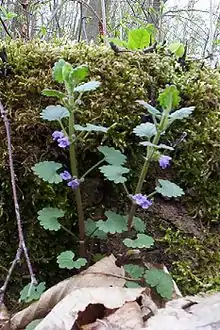Glechoma
Glechoma is a genus of flowering plants in the mint family, Lamiaceae, first described for modern science in 1753. It is distributed in northern Asia and Europe with a center of diversity in Asia, especially China. One species is naturalized in New Zealand and in North America.[1][2][3][4]
| Glechoma | |
|---|---|
 | |
| Glechoma hederacea | |
| Scientific classification | |
| Kingdom: | Plantae |
| Clade: | Tracheophytes |
| Clade: | Angiosperms |
| Clade: | Eudicots |
| Clade: | Asterids |
| Order: | Lamiales |
| Family: | Lamiaceae |
| Subfamily: | Nepetoideae |
| Tribe: | Mentheae |
| Genus: | Glechoma L. |
| Synonyms[1] | |
| |
These plants are perennial herbs with stolons. The stems are prostrate or upright and bear leaf blades on long petioles. The inflorescences arising from the leaf axils have two to many flowers. The tubular corolla has two lobed lips,[3] and is generally blue-violet.[2] The genus is closely related to Marmoritis[2] but closer still to Meehania, and some species have in the past been moved between the latter genus and Glechoma.[5]
- Species
- [1]
- Glechoma biondiana (Diels) C.Y.Wu & C.Chen - Gansu, Hebei, Henan, Hubei, Shaanxi, Sichuan
- Glechoma grandis (A.Gray) Kuprianova - Japan, Taiwan, Jiangsu
- Glechoma hederacea L. – ground-ivy, creeping charlie - much of Europe, much of Russia, Central Asia, Xinjiang; naturalized in New Zealand and North America
- Glechoma hirsuta Waldst. & Kit. - eastern and southeastern Europe
- Glechoma longituba (Nakai) Kuprian. - Vietnam, Korea, eastern + central China, Russian Far East (Amur, Primorye)
- Glechoma × pannonica Borbás - eastern Russia, Ukraine, Hungary, Baltic Republics (G. hederacea × G. hirsuta)
- Glechoma sardoa Halácsy & Wettst. - Sardinia
- Glechoma sinograndis C.Y.Wu - Yunnan
Etymology
Glechoma is said to derive from the Greek name glechon for pennyroyal, Mentha pulegium.[6]
Ecology
Insects found on Glechoma include the carpenter bee Xylocopa sinensis, which robs nectar from G. longituba.[7]
References
- Kew World Checklist of Selected Plant Families
- Jang, T. and S. Hong. (2010). Comparative pollen morphology of Glechoma and Marmoritis (Nepetinae, Lamiaceae). Journal of Systematics and Evolution 48(6), 464-73.
- Flora of China Vol. 17 Page 118 活血丹属 huo xue dan shu Glechoma Linnaeus, Sp. Pl. 2: 578. 1753.
- Biota of North America Program 2013 county distribution map
- Deng, Tao et al. (2015): Does the Arcto-Tertiary Biogeographic Hypothesis Explain the Disjunct Distribution of Northern Hemisphere Herbaceous Plants? The Case of Meehania (Lamiaceae). PLOS ONE 10(2): e0117171. doi:10.1371/journal.pone.0117171 (Fulltext)
- "Glechoma hederacea, Ground-ivy: identification, distribution, habitat". www.first-nature.com. Retrieved 16 June 2020.
- Zhang, Y. W., et al. (2007). Nectar robbing of a carpenter bee and its effects on the reproductive fitness of Glechoma longituba (Lamiaceae). Plant Ecology 193(1), 1-13.